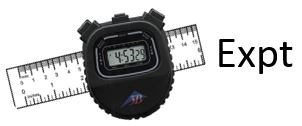PHY385 Module 2: Laws of Reflection and Refraction
Table of contents
 Activity 2.1 – The Law of Reflection
Activity 2.1 – The Law of Reflection
The PASCO OS-8500 optics bench is shown in the figure. The light source, component holders, and ray table base all attach magnetically to the bench. For proper alignment, the edge of each of these components should be mounted flush to the alignment rail, which is the raised edge that runs along one side of the bench.
Turn on the light source. The Filament Knob on the top of the unit moves the light bulb from side to side. The vertical edge of the notch at the bottom indicates the position of the light bulb filament, so that accurate measurements can be made during experiments.
Notice that the Ray Table Base is slightly slanted. When mounting the base on the Optics Bench, be sure the Ray Table slants down toward the Light Source. This ensures sharp, bright rays on the surface of the Ray Table. Either side of the Ray Table may be used. One side has a rotational scale, the other has both a rotational scale and a grid that may be used for linear measurements.
The Slit Plate is attached to a component holder between the Light Source and the Ray Table. Adjusting the distance between the Light Source and the Slit Plate can vary the quality of the rays. Narrower, less divergent rays may be obtained by sliding the Light Source farther away from the slits, but there is a corresponding loss of brightness.
Single Ray Setup
The law of reflection is most easily investigated using a single ray. This can be obtained by using the Slit Mask, as shown the figure below, to block all but the desired ray. For accurate measurements using the rotational scale, the incident ray must pass directly through the center of the Ray Table. To accomplish this, alternately adjust:
- the lateral position of the Slit Plate on its Component Holder,
- the position of the light source filament with respect to the optical axis, and
- the rotation of the Ray Table.
When one of the rays is aligned in this manner, place the Slit Mask on the other side of the Component Holder to block all but the desired ray.
Carefully align the flat reflecting surface of the mirror with the a line on the ray table that is perpendicular to the ray of light. With the mirror properly aligned, the ray is normal to the reflecting surface, and reflects back onto itself.
- Rotate the Ray table and observe the light ray.The angles of incidence and reflection are measured with respect to the normal to the reflecting surface.Choose angles of incidence of 10°, 20°, 30°, 40°, 50°, 60°, 70° and 80°, and measure the angle of reflection.Repeat your measurements with the incident ray coming from the opposite side.Compare the two sets of measurements, and estimate the error in your individual angle measurements.Are the two measurements “within error”? [Please fill in your answers in your notebook in a table similar to the one below.]
|
θi |
Δθi |
θr |
Δθr |
|
Notes |
|
10° |
|
|
|
|
|
|
20° |
|
|
|
|
|
|
30° |
|
|
|
|
|
|
40° |
|
|
|
|
|
|
50° |
|
|
|
|
|
|
60° |
|
|
|
|
|
|
70° |
|
|
|
|
|
|
80° |
|
|
|
|
|
- Are there any sources of systematic error in this experiment? (Systematic error is not necessarily random or governed by Gaussian statistics, and it may, in principle, be eliminated with careful experimental practices.)
 Activity 2.2 – The Law of Refraction (Snell’s Law)
Activity 2.2 – The Law of Refraction (Snell’s Law)
Set up the equipment as you did in Activity 2.1. Align the flat surface of the Cylindrical Lens with a line on the Ray Table that is perpendicular to the incident ray. With the lens properly aligned, the radial lines extending from the centre of the degree scale will all be perpendicular to the circular surface of the lens.
- Rotate the Ray table and observe the light ray.The angles of incidence and refraction are measured with respect to the normal to the reflecting surface.Choose angles of incidence of 10°, 20°, 30°, 40°, 50°, 60°, 70° and 80°, and measure the angle of refraction.Construct a graph if sin(θ2) on the horizontal axis, and sin(θ1) on the vertical axis [See an example template on the next page].Draw the best fit straight line for your data, and measure the slope to obtain the index of refraction, n, of acrylic (assume that the index of refraction of air is 1.000).
|
θ1 |
sin(θ1) |
θ2 |
sin(θ2) |
Notes |
|
10° |
|
|
|
|
|
20° |
|
|
|
|
|
30° |
|
|
|
|
|
40° |
|
|
|
|
|
50° |
|
|
|
|
|
60° |
|
|
|
|
|
70° |
|
|
|
|
|
80° |
|
|
|
|
 Activity 2.3 – Total Internal Reflection
Activity 2.3 – Total Internal Reflection
In Activity 2.2, you determined the relationship that exists between the angle of incidence and the angle of refraction for light passing from air into a more optically dense medium. Does the same relationship hold between the angles of incidence and refraction for light passing out of a more optically dense medium back into air? That is to say, if the light is travelling in the opposite direction, is the law of refraction the same or different?
Set up the equipment as you did for Activity 2.2. Rotate the Cylindrical Lens by 180° so that the incident ray passes through the curved side of the lens at a normal incidence, and then emerges from the flat side at the centre of the Ray Table.
- Rotate the Ray table and observe the light ray.The angles of incidence and refraction are measured with respect to the normal to the reflecting surface.Choose angles of incidence of 10°, 20°, 30°, 40°, 50°, 60°, 70° and 80°, and measure the angle of refraction (if you can’t use all these angles, make a note of that!).What is the critical angle for total internal reflection?Knowing that sin(θc)=1/n, what is the index of refraction using this single measurement?
|
θ1 |
θ2 |
Notes |
|
10° |
|
|
|
20° |
|
|
|
30° |
|
|
|
40° |
|
|
|
50° |
|
|
|
60° |
|
|
|
70° |
|
|
|
80° |
|
|
- Measure the angle of incidence corresponding to angles of refraction of 10°, 20°, 30°, 40°, 50°, 60°, 70° and 80°.Compare these numbers to the results of Activity 2.2, when the ray propagation direction was reversed.The “principle of reversibility” in optics states: “Any actual ray of light in an optical system, if reversed in direction, will retrace the same path backward.”Do your measurements agree with this principle?
|
θ1 |
Δθ1 |
θ2 |
Δθ2 |
Notes |
|
|
|
10° |
|
|
|
|
|
20° |
|
|
|
|
|
30° |
|
|
|
|
|
40° |
|
|
|
|
|
50° |
|
|
|
|
|
60° |
|
|
|
|
|
70° |
|
|
|
|
|
80° |
|
|
 Activity 2.4 – Problem Solving
Activity 2.4 – Problem Solving
Problems 4.9, 4.32, 4.41 and 4.42 from the book.

